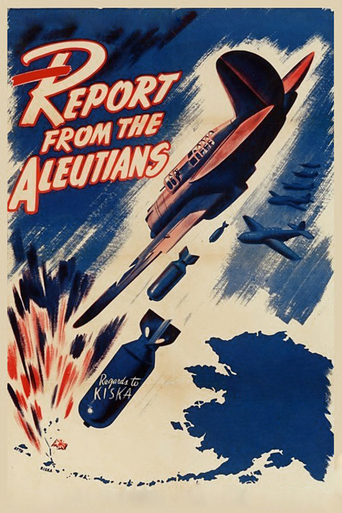grantss
John Huston's WW2 documentary on the Aleutians campaign.I was intrigued by this documentary as the Aleutians campaign is not covered much in history books or documentaries. Directed by the great John Huston, with some rare footage, what can go wrong?Well, actually, a lot. The biggest problem is that John Huston decided to narrate the movie himself. His delivery is incredibly off-putting: flowery, bombastic, verbose and all about style rather than substance. Yes, it was a propaganda film, so a bit of salesmanship was required, but a bit more subtlety would have helped the message go down. The content itself, while showing the daily operations on the US forces in the Aleutians, especially the USAAF, well, doesn't have much of the bigger picture. All we know is the US are on one island, Adak, and the Japanese are on another, Kiska, and the Americans are bombing Kiska on a regular basis. (Don't get me started on how many times Huston says "Kiska"! I grew sick of the word quite quickly). That's it.Quite disappointing.
MartinHafer
During the war, Hollywood became an official propaganda arm of the US government. This unusual relationship meant that Hollywood could use its money and expertise to make high quality films...much higher than the military itself could normally make. That's why the likes of John Ford and Frank Capra made documentaries...very good ones at that. In the case of "Report from the Aleutians", the young but very successful John Huston helmed this project.The film is about a portion of WWII that few would remember today. Believe it or not, war DID affect Alaska and some tough battles between Japanese and American troops occurred. This coincided, at times, with the attack on Midway Island....as the Aleutian attack was meant as a diversion...one that ultimately failed.Using excellent footage of the day, nice narration (by the director's father, Walter) and an overall high quality of the project make this one worth seeing...especially if you are a history lover like me.
Robert J. Maxwell
One of John Huston's contributions to the war effort. His engaging voice narrates the facts of being in the armed forces and stationed on one of the Aleutian Islands, which extend southwestward from Alaska. The narration begins with an unsparing look at the geography of the archipelago -- rough and volcanic, treeless, and a merciless climate.By the time of this release, the Japanese had landed on Kiska, one of the outer islands, and had made a naval feint to distract the US fleet from a defense of Midway. The feint failed. The on-and-off conflict with the Japanese went on for some time, mostly consisting of our bombing their positions whenever the weather allowed. In the end, the US Army landed on the Japanese-held islands only to find they had folded their tents and silently stolen away.The documentary is kind of stuck with a description of humdrum work in a dreary place, leading to an extended salute to the men who run the supplies in and out of Dutch Harbor, the engineers who drive the bulldozers. The men wear old-fashioned campaign hats, carry Springfield rifles with old-fashioned long bayonets, and some wear the broad-brimmed pre-war steel helmets.We see the usual scenes. Mail call is a treasure. The food is awful -- powdered eggs and canned this-and-that. They play old songs on guitars and harmonicas. Everyone attends services by Catholic, Protestant, and Jewish chaplains. No booze, no women. However, the troops are cheerful and morale is high. Nothing can blunt the keenness of these gum-chewing boys in their parkas.There are some finely done shots of airplanes taking off and landing -- P-39s, P-38s, P-40s, B-17s, B-26s, and B-24s. It's startling to see an airplane like the P-38, with its tricycle landing gear, plowing at speed through a foot of water and creating a moving fountain of gray that masks the airplane itself except for its dark nose which juts out ahead of the watery curtain.The film ends with a bombing mission of nine B-17s over Kiska. It's no more alluring than life back in Dutch Harbor although far more dangerous. There are bursts of flak, and though there have been casualties on other missions, this one returns safely.
rsoonsa
Director John Huston, while a member of the U.S. Army Signal Corps in 1943, creates an Academy Award winning documentary, which he narrates with assistance from his actor father Walter, treating of the Armed Forces' successful effort to prevent the fall of the Aleutian Islands to advancing Japanese troops who had captured several islets. Although no claim can be reasonably made that this location was of major strategic importance during the War, it presented enormous tactical and logistic difficulty for those assigned there, and Huston's color film demonstrates the determined ensemble work upon the outpost of Adak by a wide range of military specialists who combat loneliness and boredom along with notably severe weather conditions. The work was made over a six month period, and is climaxed by the preparations for, followed by an actual filming of, a bombing run over Japanese-occupied Kiska, wherein Huston nearly lost his life, and which is significant for its combat footage and for the atmosphere of suspense present in the viewer who wonders if all will return safely.





